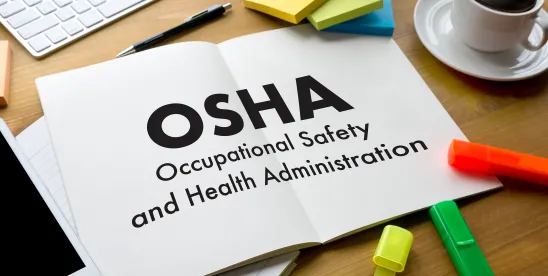In the evolving landscape of workplace safety regulations, it is essential for construction employers to stay well-informed about the Occupational Safety and Health Administration’s (OSHA) protocols and guidelines. Our series, “Top 10 Things Every Employer Should Know About OSHA,” breaks down critical aspects ranging from the rights and responsibilities during OSHA inspections to intricacies of compliance standards and potential citation scenarios. This comprehensive guide aims to empower employers with the knowledge needed to navigate OSHA regulations effectively, ensuring safer work environments and minimizing legal risks.
Here’s a recap of our list of the top 10 things every employer should know about OSHA:
No. 1 – Walkaround Representatives
Employers and employees have the right to have representatives present during an OSHA site inspection.
According to 29 CFR 1903.8(c), employers and employees have the right to authorize a representative to accompany OSHA officials during workplace inspections for the purpose of aiding the inspection (also known as walkaround representatives). OSHA regulations require no specific qualifications for employer representatives or for employee representatives who are employed by the employer. We encourage all employers to have a designated walkaround representative present during OSHA inspections, which could include legal counsel.
No. 2 – Be Present in Manager Interviews
We all know that OSHA has the right to interview folks as part of an investigation. Whether a company representative and the company attorney can also attend an interview depends on the position of the person being interviewed.
If the person to be interviewed is a non-managerial employee, OSHA can conduct the interview in private, outside the presence of the employer or the employer’s representatives. Not so with managerial employees. If OSHA wants to interview a management-level employee, the employer has the right to have a company representative and/or attorney present.
No. 3 – Employees Have Rights When It Comes to OSHA Interviews
Although OSHA has the right to conduct private, one-on-one interviews with a company’s non-managerial employees, those same employees have rights too. Read the full article for details and things to consider.
No. 4 – OSHA Must Issue a Citation Within Six Months
OSHA has a time limit on issuing citations. It must issue a citation within six months of the occurrence of any violation. The only exception to this rule is where the employer has concealed the violative condition or misled OSHA. If such a situation occurs, OSHA must issue the citation within six months from the date that OSHA learns, or should have known, of the condition.
So, the moral of the story is just because it’s been a couple months since an OSHA inspection does not mean OSHA has decided not to issue a citation. You can check on the status of OSHA’s investigation by reviewing the OSHA establishment search page to see whether OSHA has closed its inspection or not.
No 5. – OSHA Can Issue Citations for Unsafe Work Conditions That Have Not Resulted in an Employee Injury
Most frequently, employers do not hear from OSHA unless there is a reported workplace injury. When a reported workplace injury occurs, OSHA performs a walkthrough inspection of the worksite and may ultimately issue a citation for hazardous conditions OSHA believes may have caused or contributed to the incident. However, OSHA is not limited to issuing citations for hazardous conditions that may have caused or contributed to a workplace injury. Rather, OSHA can cite employers for any and all hazardous conditions to which workers may have been exposed regardless of whether the cited condition was in any way related to the incident.
No 6. – But No One Was There? OSHA Can Still Cite for Unsafe Work Conditions Where Workers Were Not Exposed
We often hear, “OSHA can’t cite me because I didn’t employ the injured worker.” Unfortunately, this statement is often untrue.
Under OSHA’s Multi-Employer Doctrine, if you are an employer on a worksite where other companies are also performing work (e.g., construction sites and oil/gas well sites), you can be subject to citation for workplace hazards to which other companies’ employees are exposed. OSHA created the Multi-Employer Doctrine in recognition that there are many circumstances in which multiple employers will be working on a single worksite at the same time thereby affecting the working conditions to which all workers are exposed.
No. 7 – OSHA Can Issue Citations for Unsafe Work Conditions That Do Not Violate Any Specific OSHA Standard
Many employers have a false notion that OSHA can’t issue a citation if there is no specific standard violated.
The reality is, however, that OSHA has a catchall/gap filler provision that allows it to cite an employer even if no specific standard was violated: the “General Duty Clause,” Section 5(a)(1) of the Occupational Safety and Health Act. OSHA can cite employers for violations of the General Duty Clause if a recognized serious hazard exists in the workplace and the employer doesn’t take reasonable steps to prevent or abate the hazard. The General Duty Clause is used only where there is no standard that applies to the particular hazard.
No. 8 – Employers Have 15 Working Days to Contest a Citation but Have the Option to Negotiate a Settlement with OSHA Before That Deadline
What happens if OSHA issues a citation and you do not agree with any or all of it? You have 15 working days from the date you receive the citation to contest in writing the citation, proposed penalty, and/or the abatement date. Read the full article to learn more about your options and how to reach a favorable settlement.
No. 9 – The Particulars on OSHA Violations: How Much Notice Is Enough?
Just what does an OSHA citation have to include? Section 9(a) of the Occupational Safety and Health Act requires that citations “describe with particularity the nature of the violation, including a reference to the provision of the Act, standard, rule, regulation, or order alleged to have been violated.”
This statutory mandate is designed to ensure that OSHA properly informs employers of alleged violations so they can correct hazards promptly and avoid unnecessary litigation. However, the Occupational Safety and Health Review Commission and the courts have consistently interpreted this requirement to mean that citations need only provide employers with “fair notice” of the violation. In other words, as long as an employer is put on notice that a particular condition may violate OSHA standards, additional specifics can be obtained through discovery. As a result, OSHA often issues citations with broad language rather than granular detail.
No. 10 – Unlocking the Secrets of OSHA Inspections Through FOIA Requests
Did you know that you can request files from OSHA? Under the Freedom of Information Act (FOIA), employers, employees, and third parties have the right to request documents from OSHA’s inspection files. These records provide valuable insight into the evidence and reasoning behind OSHA’s decisions, including citations issued during site inspections. They can also be critical in legal proceedings, including lawsuits related to workplace safety.




 />i
/>i

